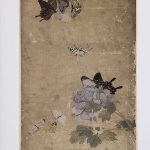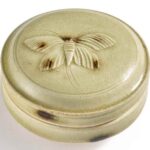Joseon / Choson Dynasty. The Joseon dynasty (also transcribed as Chosŏn or Chosen, literally translated as Great Korean Country) was a Korean dynastic kingdom that lasted for approximately five centuries. Joseon was founded by Yi Seong-gye in July 1392 and was replaced by the Korean Empire in October 1897. It was founded following the aftermath of the overthrow of Goryeo in what is today the city of Kaesong. Early on, Korea was retitled and the capital was relocated to modern-day Seoul. The kingdom’s northernmost borders were expanded to the natural boundaries at the rivers of Amnok and Tuman through the subjugation of the Jurchens. Joseon was the last dynasty of Korea and its longest-ruling Confucian dynasty.
The Mid-Joseon dynasty painting styles moved towards increased realism. A national painting style of landscapes called “true view” began – moving from the traditional Chinese style of idealized general landscapes to particular locations exactly rendered. While not photographic, the style was academic enough to become established and supported as a standardized style in Korean painting. At this time China ceased to have pre-eminent influence, Korean art took its own course, and became increasingly distinctive to the traditional Chinese painting.
Ceramics are a form of popular art during the Joseon Dynasty. Examples of ceramics include white porcelain or white porcelain decorated with cobalt, copper red underglaze, blue underglaze and iron underglaze. Ceramics from the Joseon period differ from other periods because artists felt that each piece of art deserved its own uniquely cultivated personality. Reference: Wikipedia
A MOTHER-OF-PEARL INLAID BLACK LACQUER TABLE STAND Joseon dynasty (1392-1897) The rectangular top inlaid in mother-of-pearl with a central shaped panel of butterflies hovering above a flowering bush issuing from rocks, all reserved on a ground composed of large irregular pieces of mother-of-pearl, further inlay of a dot-and-wave band on the edge and of blossoms on the recessed apron, the four shaped supports with an overall “tortoise-shell” pattern picked out in mother-of-pearl 2 7/8 x 17 1/4 x 8 3/8in (7.5 x 44 x 22.5cm)
Sold for US$ 1,875 (£ 1,580) inc. premium at Bonham’s in 2016
Small hexagonal vase with long neck. Made of porcelain with underglaze blue decoration of peonies and butterflies.
This long-necked bottle from the late Joseon period features a hexagonal shape made using a chamfering technique, whereby the vessel is completed by cutting the exterior. The angled inside and the outside of the neck suggest that it was made separately and connected to the body. The cobalt-blue designs decorating the bottle’s surface include a geometric pattern encircling the area beneath the lip, fret patterns around the lower neck and shoulder, and a main motif of peony sprays with bees and butterflies elaborately depicted using a traditional outlining technique. The foot, trimmed to have a reverse trapezoidal form, has sand-spur marks used to stack with other vessels for firing. Due to its complex production process and elaborate decoration, the vessel is regarded as a fine example of the high-quality works produced at the court-sponsored kilns in Bunwon, Gwangju.
Reference: © The Trustees of the British Museum
PAIR OF RARE KOREAN CHOSON CANDLESTICK HOLDERS
Iron with butterfly decoration, Korea, 19th c. 34″ x 10″ x 8 3/4″
Some elements missing or replaced. Worn surface, flaking to surface, some components slightly bent or misshapen.
Sold for $2,000 at Rago Arts and Auction Center in 2017
Butterflies and Peonies mid- to late19th century Attributed to Nam Gye-u Korean Famous for his elegant paintings of butterflies, the literati artist Nam Gye-u earned the nickname “Nam Butterfly.” This scroll, though lacking the artist’s signature or seal, closely reflects his style. It was likely originally one panel of a multipanel screen, with each scene depicting butterflies fluttering amid a different flowering plant. Here, the subtly hued yet luscious peonies provide an ideal foil for butterflies of varying color and texture. Oversized relative to the peony blossoms, the butterflies command the viewer’s attention, as intended by the artist.
Reference: The Metropolitan Museum of Art
A Rare Mother-of-Pearl Inlaid ‘Floral Vine’ Lacquer Box and Cover Korea, Chosŏn Dynasty, 15th / 16th century of rectangular form supported on a flat base, finely inlaid in iridescent sections of mother-of-pearl slightly stained to gold on a black lacquer ground with peony blossoms and buds wreathed in scrolling floral vines, scattered overall with eight hovering butterflies, four of them with plain gold wings, and four others of a black and gold variety 11 by 35.3 by 28.8 cm., 4 3/8 by 13 7/8 by 11 3/8 in.
Sold for 1,240,000 HKD at Sotheby’s in 2014
Storage jar of porcelain, decorated with flowers and butterflies in copper red pigment under clear glaze
This storage jar dates to the late Choson period (1392-1910) and is decorated with a motif of flowers and butterflies in under-glaze copper red. Almost all extant examples of copper-decorated white porcelain date from the eighteenth century or later. Because of the greyish-white glaze and faint blue or green hue, it is believed to have been made in a local kiln. The technique of decorating ceramics with copper-red developed in Korea in the 12th century when it was used on celadon wares, but it was virtually unused in the making of white porcelain until the mid 18th century. Because of the unpredictability of copper, the colour would sometimes blur or turn green or brown after high-temperature firing.
p>Reference: © Victoria and Albert Museum








